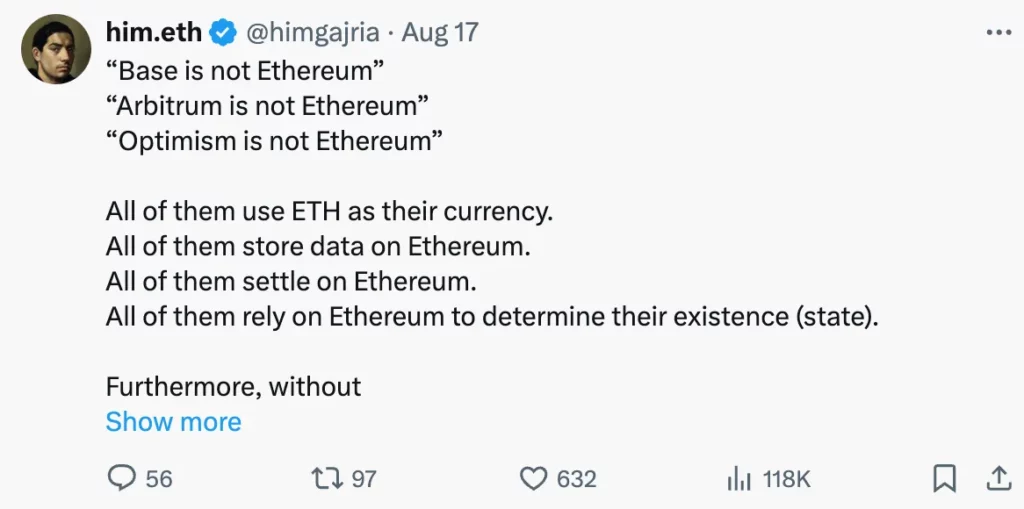Symbiosis or Fragmentation? The Relationship Between Layer 2 and Ethereum

Ethereum has recently faced some challenges. Critics have pointed out that ETH’s performance has lagged behind competitors like SOL, with many attributing this to the rise of Layer 2 (L2) solutions and the shift of users away from Ethereum’s main chain.
This raises a fundamental question: Are Layer 2s still part of Ethereum?
As is often the case in crypto, the answer is both simple and complex. Let’s dive into both sides of the debate and explore the true relationship between Ethereum and Layer 2s.
Symbiotic Relationship or Fragmentation?
From the outset, Layer 2 solutions have been an integral part of Ethereum’s rollup-centric roadmap. They were designed to extend Ethereum’s capabilities—both technically and culturally—by scaling its operations and attracting a broader user base.
In essence, L2s are deeply connected to Ethereum. They rely on ETH as the native currency, benefit from Ethereum’s security guarantees, and use Ethereum for data storage and settlement. This relationship is akin to a startup leveraging its parent company’s infrastructure and brand recognition—a win-win situation for both sides.

The symbiosis between L2s and Ethereum is undeniable. L2s thrive on Ethereum’s robust infrastructure and security, while Ethereum benefits from the increased activity and demand for ETH, further solidifying its position as a valuable asset.
L2s offer lower fees and faster transaction times, making it easier for developers to build diverse applications. Consider the explosive growth of memecoins on Base, or the rise of SocialFi platforms like Farcaster, which have unlocked new markets for users.
Moreover, L2s are becoming major hubs for DeFi activity, with ETH playing a central role in the ecosystem. Look at the numbers: Arbitrum, Optimism, Base—these chains are dominated by ETH-related assets.
Vampire Attack?
However, one of the key criticisms against Ethereum’s rollup-centric scaling strategy is the fear that L2s might eventually abandon Ethereum. Yes, L2s and Ethereum currently function like a harmonious family, but what if L2s build their own empires and cut ties with Ethereum entirely? Imagine no longer relying on Ethereum for security, no longer using ETH for gas, and no longer requiring Ethereum’s block space.
This concern of “L2s going rogue” is not unfounded. Technically, L2s could create independent ecosystems with their own validators, fully owning the modular blockchain stack. But is this the future—an eventual breakup between L2s and Ethereum? Not necessarily.
Building a new ecosystem or launching another Layer 1 blockchain is a complex and resource-intensive task. Bootstrapping a validator set is a significant challenge, and constructing a new Layer 1 could lead to the same scalability issues Ethereum currently faces. If L2s intended to go down this route, they would likely have done so from the start.
The Secret to Balance?
Instead, L2 builders are playing a different game. Their primary focus is on scaling transactions, attracting developers, incentivizing them to build applications for diverse use cases, and onboarding new users into crypto, while Ethereum handles the security and decentralization.
That said, the evolving L2 landscape is not without its foreseeable challenges. It’s a curious paradox: on one hand, the rise of L2s demonstrates the success of the rollup-centric roadmap. On the other, this growth is also a potential source of fragmentation.
We can all agree that there are too many L2s—too many copycats with little differentiation. It’s akin to thousands of startups chasing the same market, all making the same promises. This isn’t healthy.
What we need are essential L2s—those that offer something distinct and meaningful. Security, diversity of applications, go-to-market strategies—these are areas where true innovation should happen.
Maintaining the Ethereum Identity
Let’s not lose sight of the bigger picture. As Ethereum expands through these L2s, it’s crucial that the ecosystem still feels like Ethereum. We need to avoid the trap of fragmentation, where every player is pulling in their own direction.
L2s should be seamlessly connected. Teams are already launching technology stacks to develop a unified network of chains that share resources and offer users a smoother, faster experience. Initiatives like Superchain, AggLayer, Elastic Chain, and Orbit Chains are promising steps in this direction.
But we must remain cautious of creating echo chambers. These L2s should not become isolated universes. A healthy L2 ecosystem is one where chains work together, not in isolation. We need bridges, not moats.
Collaboration is Key
Ultimately, we need cooperation, communication, education, and shared incentives. Building shared infrastructure and standards that foster seamless connections between L2s is the only way we can truly achieve collective success.